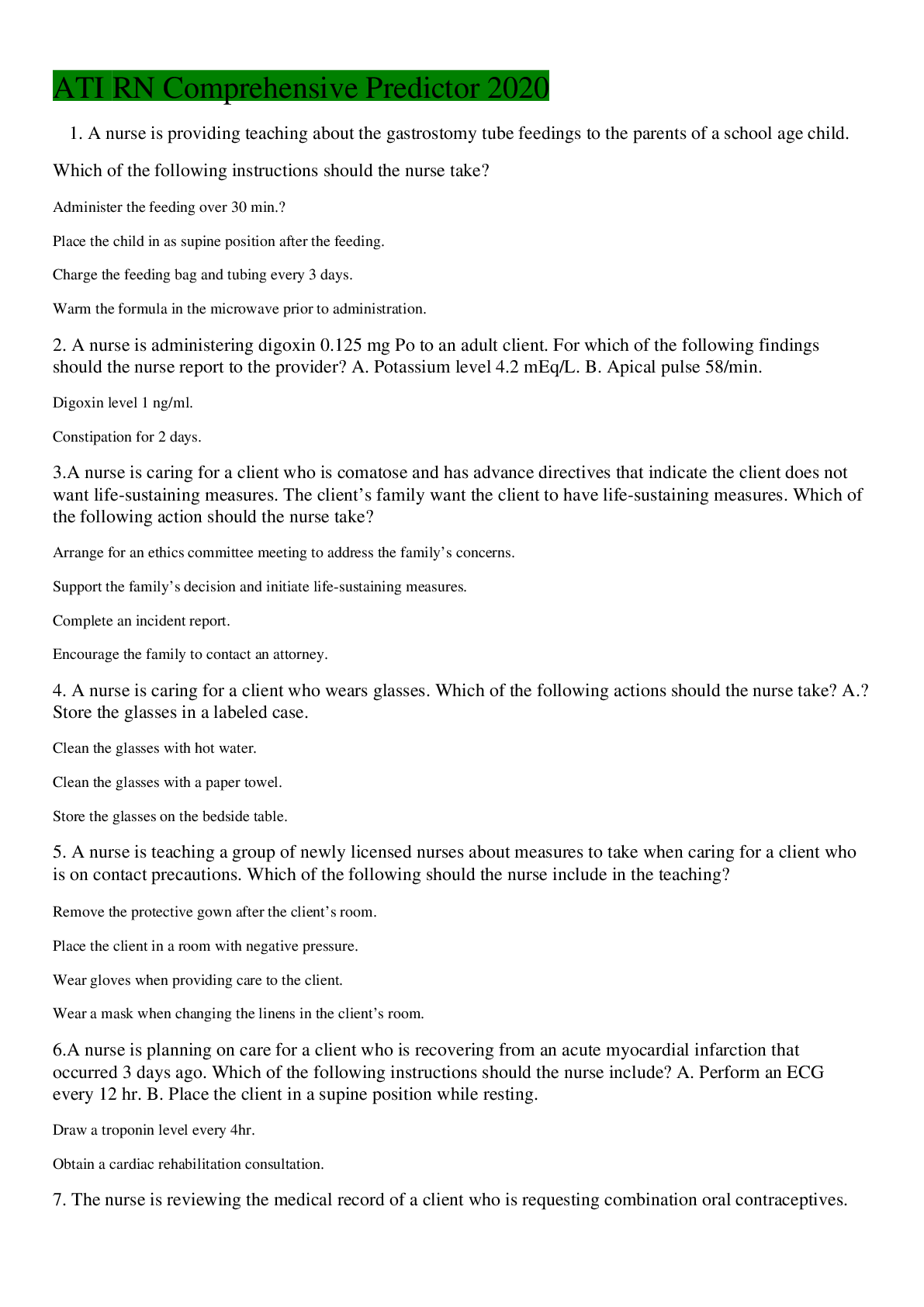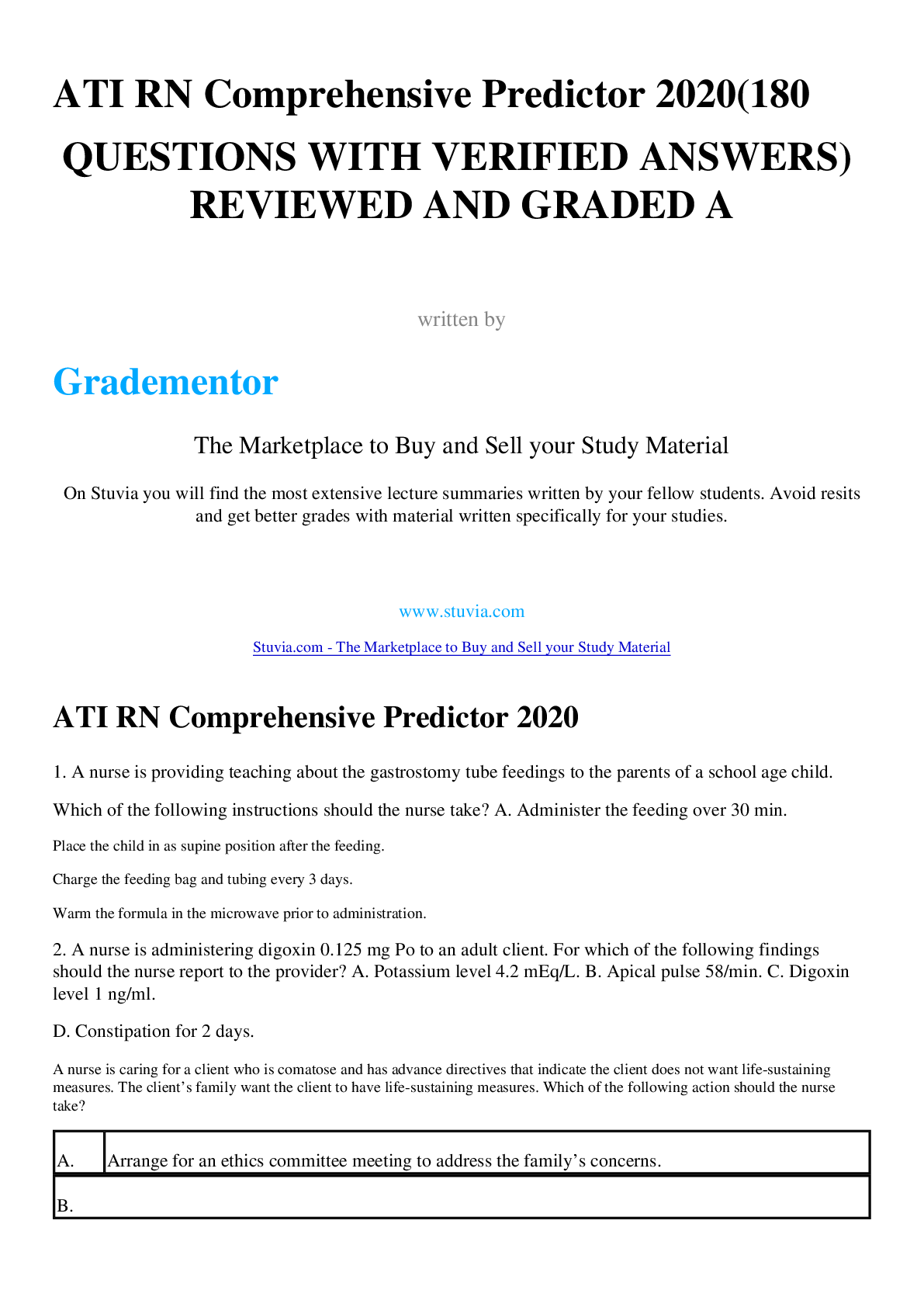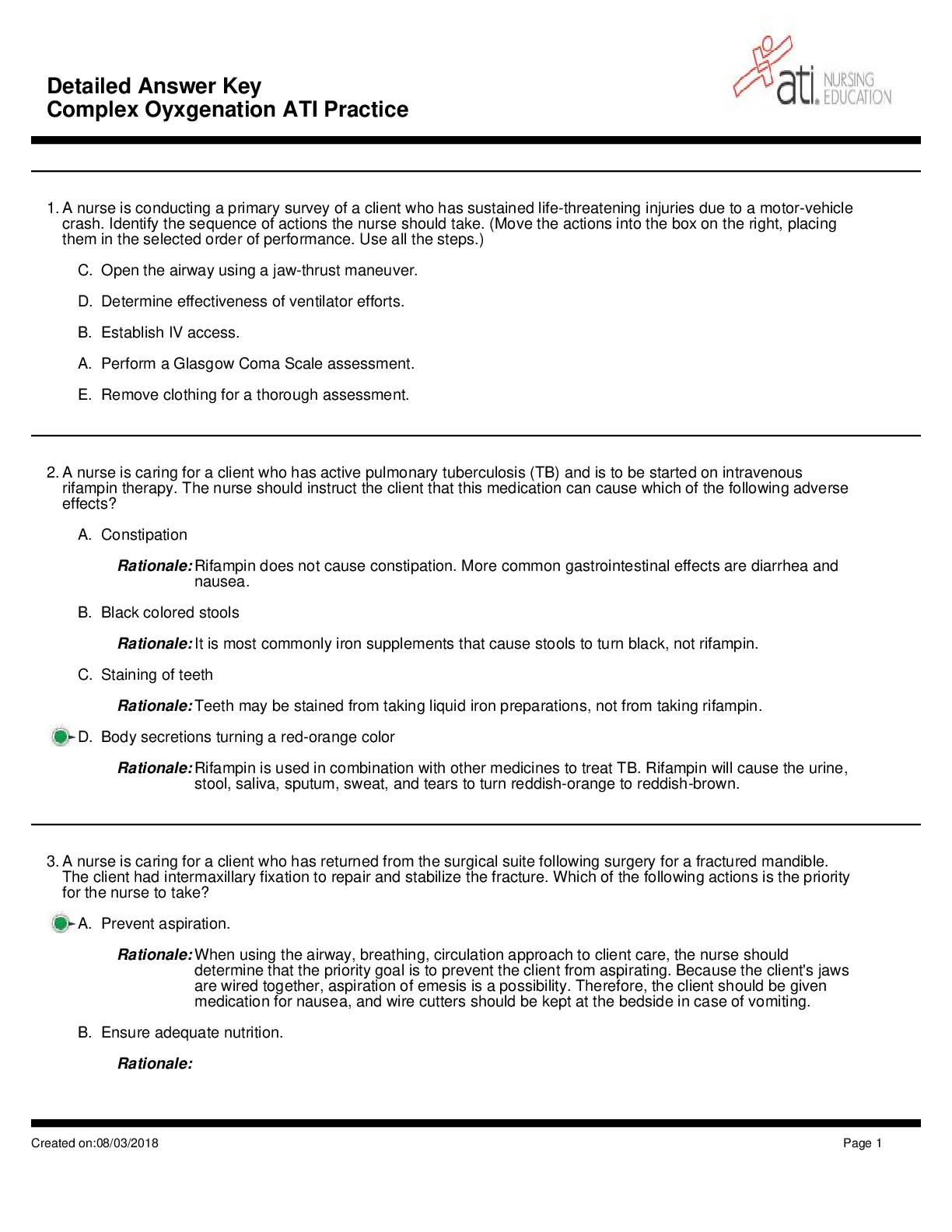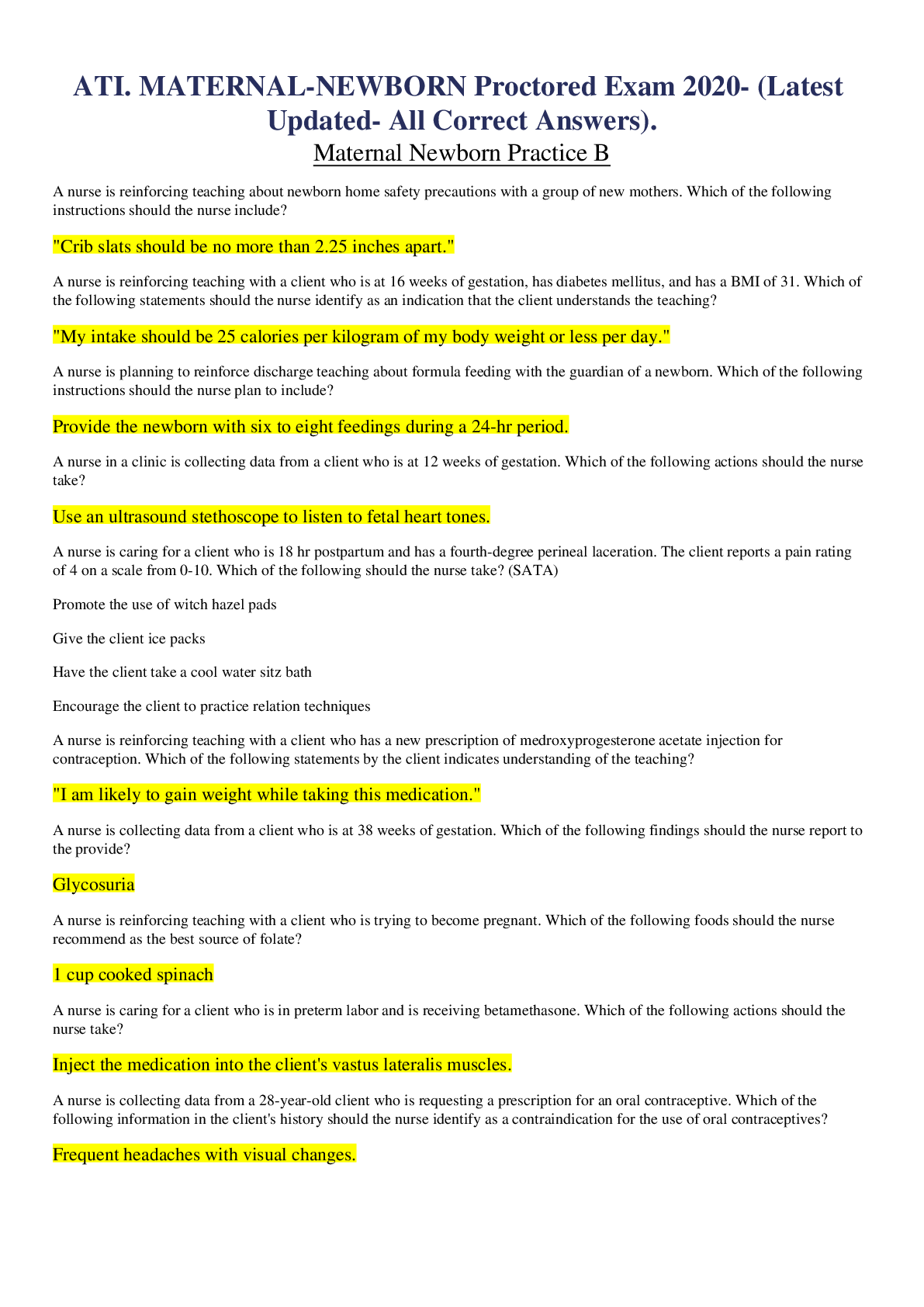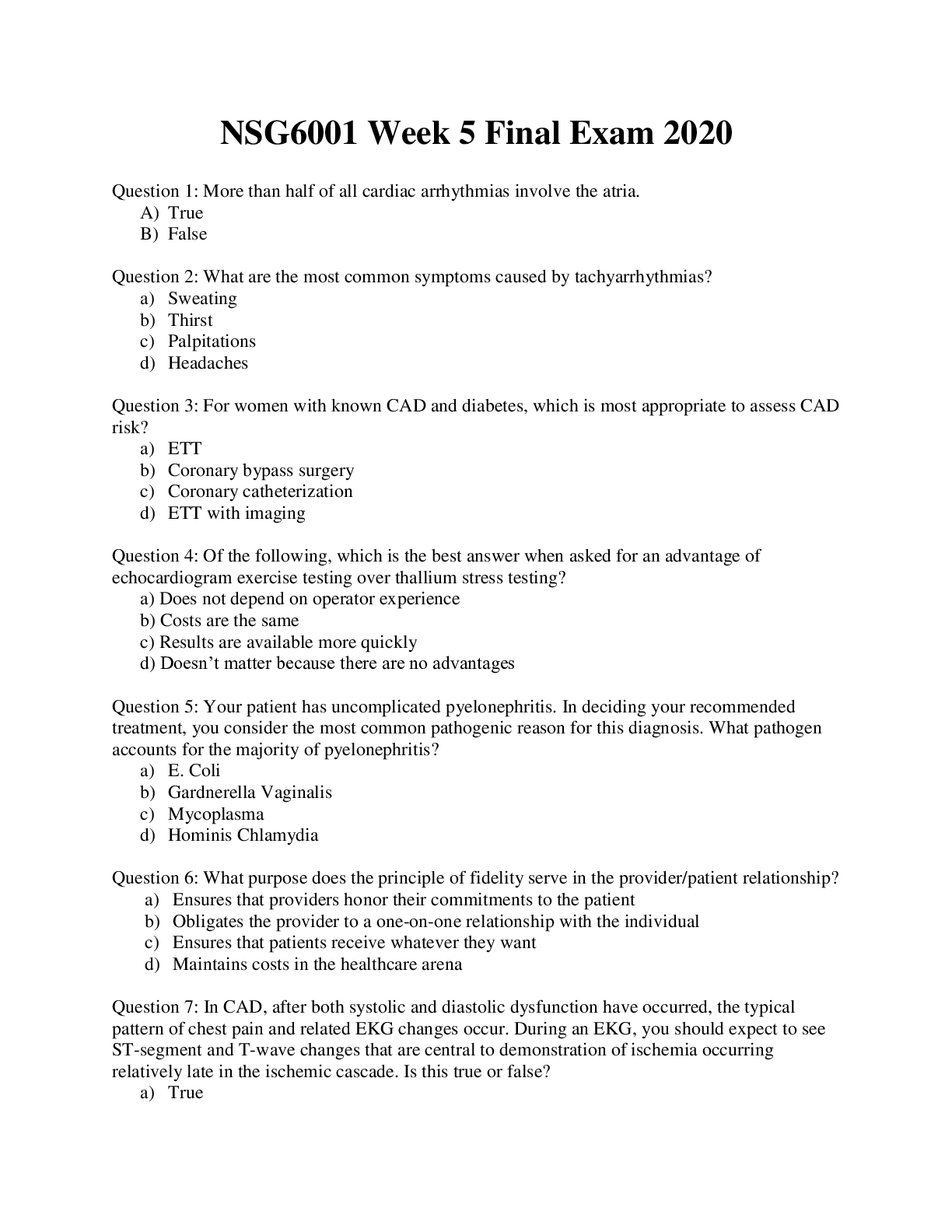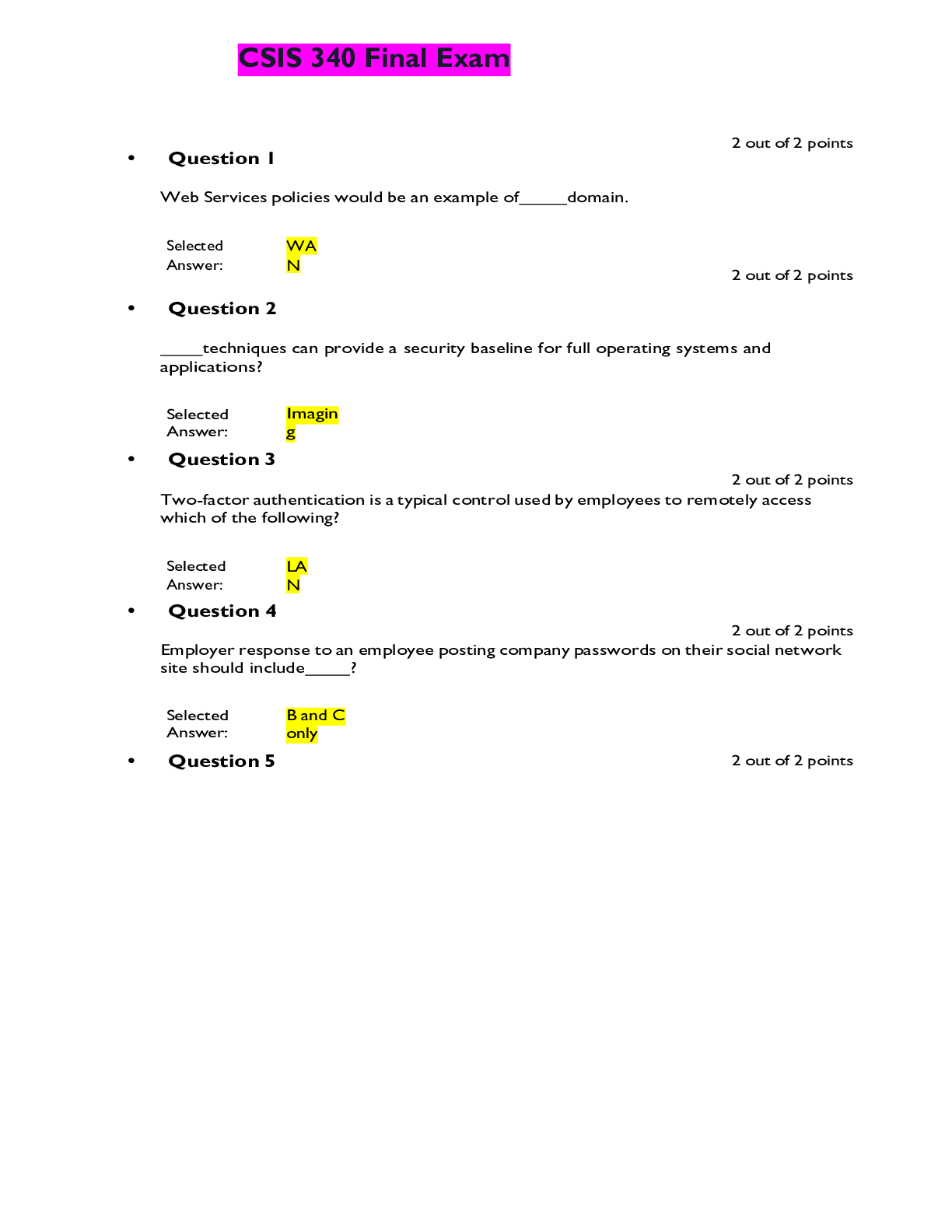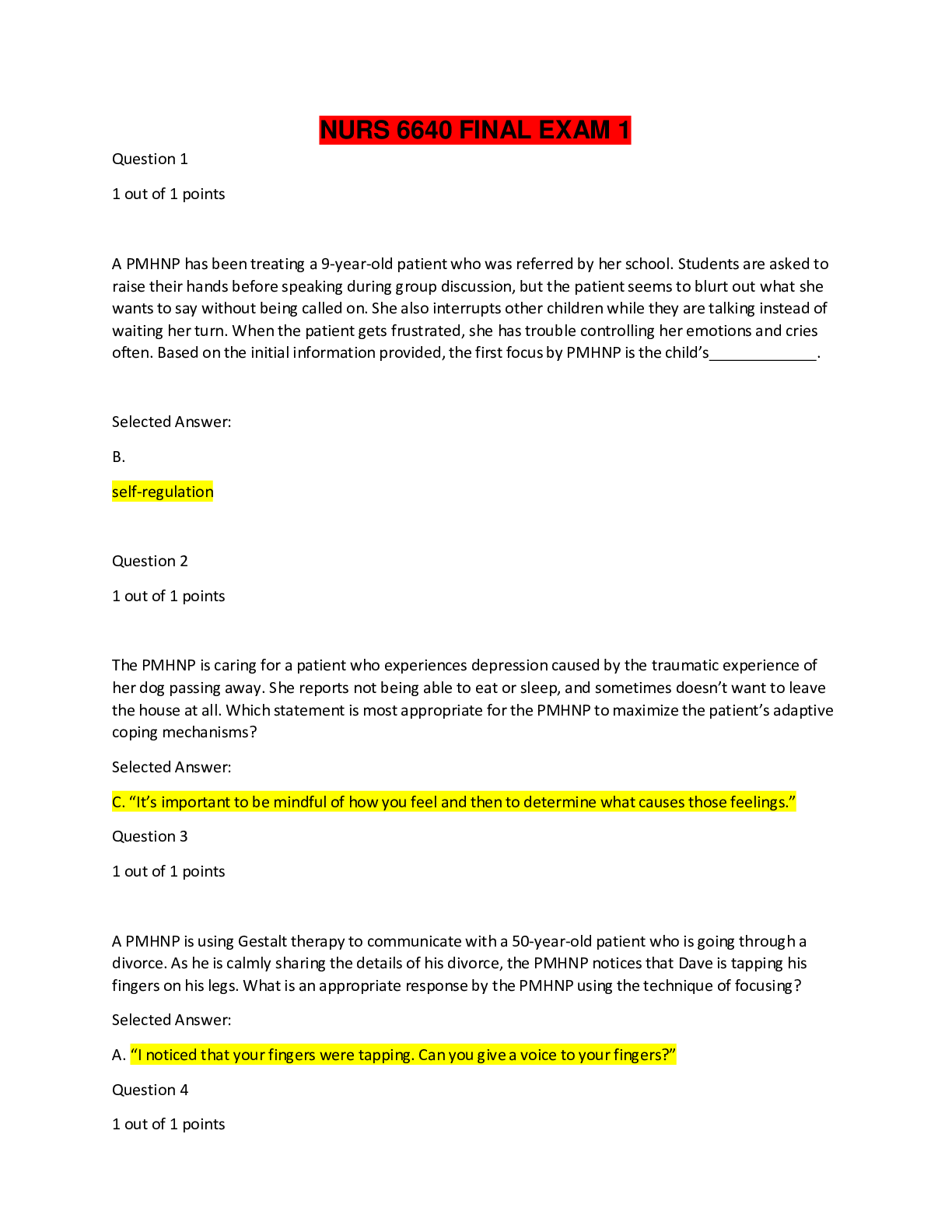*NURSING > EXAM > Certified Flight Registered Nurse Exam Prep (CFRN) 45 Questions with Verified Answers,100% CORRECT (All)
Certified Flight Registered Nurse Exam Prep (CFRN) 45 Questions with Verified Answers,100% CORRECT
Document Content and Description Below
Certified Flight Registered Nurse Exam Prep (CFRN) 45 Questions with Verified Answers Vibrations related to physiologic stressors of flightCORRECT ANSWER The WORST stressor. - motion fatigue... and sickness. -increased pain with fractures. - may increase ETCO2 - increase padding to decrease vibrations. Gravitational forces related to physiological stressors of flightCORRECT ANSWER Results in pooling of blood. Noise and physiological stressors of flight...CORRECT ANSWER Interferes most with physical assessment and decreases communication. Vision impairment and physiological stressors of flightCORRECT ANSWER Night vision affected as early as 5,000 feet mean sea level (MSL). - Avoid inside light use and use supplemental O2. Temperature and physiological stressors of flightCORRECT ANSWER Temperature drops by 2 degrees Celsius (C) for every 1,000 feet increase in altitude along with decreased humidity. - Cold, high, and dry = negative impact. What are the most common reasons for patient death during a flight?CORRECT ANSWER Cardiac tamponade Tension pneumothorax Hypovolemia. Fuel vapors can cause...CORRECT ANSWER Eye irritation Altered mental status (AMS). nausea. Flicker vertigo and physiologic stressors of flight...CORRECT ANSWER Seizures - cover patient's eyes to prevent. Flicker vertigo is sunlight through the wind-milling propeller. Spatial disorientation from clouds, water, or deserts may cause...CORRECT ANSWER Increases of motion sickness. Barotitis MediaCORRECT ANSWER Obstruction of eustachian tubes that causes pain, tinnitus, and vertigo on descent. Ask the patient to yawn or swallow, not chew gum, to relieve symptoms. Baro = Boyle's BarogastralgiaCORRECT ANSWER Unclamp NG/OG tube during ascent to relieve pressure. Baro = Boyle's Barodontalgia (aerodontalgia)CORRECT ANSWER Use warm compresses to relieve dental pain on ascent. Baro = Boyle's What will happen to untreated pneumothorax on ascent?CORRECT ANSWER An untreated pneumothorax will expand on ascent. May require a needle decompression or chest tube placement. BarosinusitisCORRECT ANSWER Obstruction of sinus passages may cause pain or epistaxis on ascent. Valsalva maneuvers can be used to equate pressures. Baro = Boyle's Boyle's LawCORRECT ANSWER Trapped gas expands with altitude (air splints, chest tubes, ET cuff pressure, hollow organs, increases IV fluids rate, IABP purge) Insert gastric tube and vent for gastric distension, bowel obstruction, ileus. Insert chest tube for small pneumothorax in rotor-wing transport. No air transport for pneumocephalus (air in cranial cavity). Henry's "Heineken" LawCORRECT ANSWER Nitrogen (N2) bubbles cause decompression sickness "The Bends". Charles' "Centigrade" LawCORRECT ANSWER Gas expands as temperature increases. An increase in altitude leads to a decrease in temperature. Allows you to transport a heavier patient in cooler temperatures (due to more lift from dense cooler air). Dalton' "Gang" LawCORRECT ANSWER More O2 required at higher altitude (altitude hypoxia). Gases are 21% oxygen, 78% nitrogen, 1% trace at all levels but further apart as ascend (Dalton disperse). Gay-Lussac's LawCORRECT ANSWER Pressure in the O2 tanks (change in PSI) decreases as temperature drops and increases with heat. Atmospheric pressure at sea level? 33 ft lower? 66 feet lower?CORRECT ANSWER 1 ATM = 760 torr at sea level. 33 feet below sea level = 2 ATM 66 feet below sea level = 3 ATM. Diving Emergencies: Air Gas EmbolismCORRECT ANSWER Air gas Embolism due to Boyle's Law in inexperienced divers. Breath holding compressed air during ascent forces air through alveoli into the skin in the chest and neck. Greatest pressure difference at < 4 feet depth, just below the surface. May result in a pneumothorax or ischemia or air embolism. Treatment: Transport in a pressurized cabin or < 1,000 feet MSL in rotor wing to immediate HBO. Diving Emergencies: Decompression Sickness (Henry's Law)CORRECT ANSWER Decompression Sick 1: painful joints, mottled skin, itching "cutis marmorata" Decompression Sick 2: neurologic stroke-like symptoms, AMS syncope, dizziness. "Bends" - limb joint pain from nitrogen bubbles in the joints. "Chokes" - chest pain and respiratory distress (sensation of suffocation) from nitrogen gas bubbles in the pulmonary vessels. "Staggars" - neurologic disturbances as nitrogen comes out of the blood and forms gas bubbles. Treatment: ground transport preferred for all decompression illness. Administer 100% O2 and possibly HBO therapy. Four Stages of Hypoxia - HypoxicCORRECT ANSWER Insufficient oxygen on RBCs as in altitude hypoxia. Four Stages of Hypoxia - HypemicCORRECT ANSWER lack of RBCs to carry O2 as in anemia, blood loss, CO poisoning, sickle cell disease, chronic liver disease. Transfuse with blood prior to transport. Hypemic rhymes with anemic. Four Stages of Hypoxia - HistotoxicCORRECT ANSWER Incapable of using O2 as in cyanide, carbon monoxide, alcohol, or narcotic poisoning. Four Stages of Hypoxia - StagnantCORRECT ANSWER Inability to mobilize RBCs, as in G-forces, temperature extremes, and heart failure. Types of TransportationCORRECT ANSWER Ground ambulance allows for larger pieces of equipment. Rotor-wing (helicopter) aircraft allows rapid point-to-point transportation but it is not pressurized. Use when out-of-hospital time is crucial. Fixed-wing (plane) is pressurized, larger, and great for long distance transport. Secure landing zones (LZ)CORRECT ANSWER Use a prearranged LZ to increase safety. Permanent helipad - must have 2 approach and departure headings, landing beacon, perimeter lighting on helipad, windsock, security, and a fence around the pad. Non-designated (unsecured) landing zones must be smooth and level, one approach and departure heading, with spotlights directed toward obstacles at night. Hospital helipads may be used as a meeting point with approval of facility. Operational Safety - part 1CORRECT ANSWER Make sure pilot-in-command (PIC) is aware of your presence and signals OK prior to approaching a running aircraft. Never approach aircraft during start up or shut down. Do not approach at 6 o'clock position. Approach at 3 or 9 o'clock (the side, not from behind). Use a crouching position, keep visor down to protect against rotorwash, secure loose items like paperwork. Operational Safety - Part 2CORRECT ANSWER When the aircraft is on a slope, approach from and depart to downhill direction to avoid low rotor blades. If you see a firearm at the scene, leave it in the exact position and assume it is loaded. In-flight Safety - Part 1CORRECT ANSWER Secure all equipment so they do not become projectiles. dim lights or use red, amber, blue, or green lighting. Wear seatbelts and helmets always unless you have PIC approval to take them off. Practice situational awareness by observing for hazards and report hazards by clock position and level; wires are the greatest danger. In-flight Safety - Part 2CORRECT ANSWER Evaluate combative patients prior to takeoff and consider intubation for chemical restraint for safety. You can use physical restraints too. Incarcerated patients - guard can carry a gun, but not mace or pepper spray. If aircraft is hijacked, report over the radio. Communication - part 1CORRECT ANSWER Use plain language, no abbreviations. Be familiar with NATO phonetic alphabet. Pause for a second after keying microphone. headset microphones should barely touch lips, handheld microphone 2 - 3 inches from mouth. Talk at a normal level, no yelling. Radio reports should be no longer than 60 seconds. Communication - Part 2CORRECT ANSWER Reporting hazards - announce location, hazard, heading (in that order). If pilot states, "I will be landing on Runway 33" heading upon final approach will be 330 degrees. Communicate with air traffic control every 15 minutes while in flight, every 45 minutes while grounded. Emergency action plan activated 15 minutes after failing to report in, so activated 30 minutes after last communication while in the air, 60 minutes last communication while on the ground. Radio OperationsCORRECT ANSWER VHF low band FM - greatest signal and range, but more noise interference. Simplex radio - same frequency. Multiplex - 2 or more sources over same frequency. Repeater radio repeats to another frequency, useful in mountain terrain. Crew Resource Management (CRM) and CAMTS regulations.CORRECT ANSWER PIC has ultimate authority of mission, but all crew members have the right to refuse a mission if legitimate concern. "All to go, 1 to say no." Sterile cockpit during all critical phases of flight (takeoff, landing, refueling, taking, changing headings) Uniform - protective, flame retardant clothing including sturdy footwear and reflective material on uniforms. Must allow 1/4" of space between suit and undergarments (cotton, not polyester). Helmets or headsets should be first on and last off. Visor down on helmet as much as possible. Safety and SurvivalCORRECT ANSWER Pre-mission preparation: Crew check, equipment check, and weather check. Self-induced stressors for staff: DEATH (Drugs, Exhaustion, Alcohol, Tobacco, Hypoglycemia). FAR Part 91 and FAR 135: 8 hours bottle to throttle (alcohol) to fly. Duty day is 14 hours max with total flying time of 8 hours max. What do you do if you encounter marginal weather? What about bad weather?CORRECT ANSWER Marginal weather: you can still fly during marginal weather but be cautious. Bad weather: Divert to closest facility. What are the most common causes of crashes (#1 and #2 reasons)CORRECT ANSWER Pushing the weather is the #1 cause. Night flying is the #2 cause. Navigation: Visual Flight RulesCORRECT ANSWER You can only fly weather conditions where you can see. Visual Meteorological Conditions (VMC) Navigation: Instrument Flight RulesCORRECT ANSWER Instruments required for flight in instrument meteorological conditions - IMC). A pilot may. use IFR in good weather, but cannot use VFR in bad weather. If unexpected bad weather is encountered while using VFR, what should be done?CORRECT ANSWER Switch to Inadvertent Instrument Meteorological Conditions. What are the 3 squawk codes?CORRECT ANSWER 7700 general emergencies 7600 Communication failures 7500 hijacks. Ground transport vehicle emergencies - part 1CORRECT ANSWER driver must have at least 2 years driving experience. Perform daily equipment checks. Drug testing should follow and accidents. Secure equipment. Apply at least 3 straps on patient (chest, hips, and knees). Use child safety seats. 360 degree red light or strobe visible from 500 ft and siren when critical to patient outcome. Ground transport vehicle emergencies part 2CORRECT ANSWER [Show More]
Last updated: 7 months ago
Preview 1 out of 9 pages
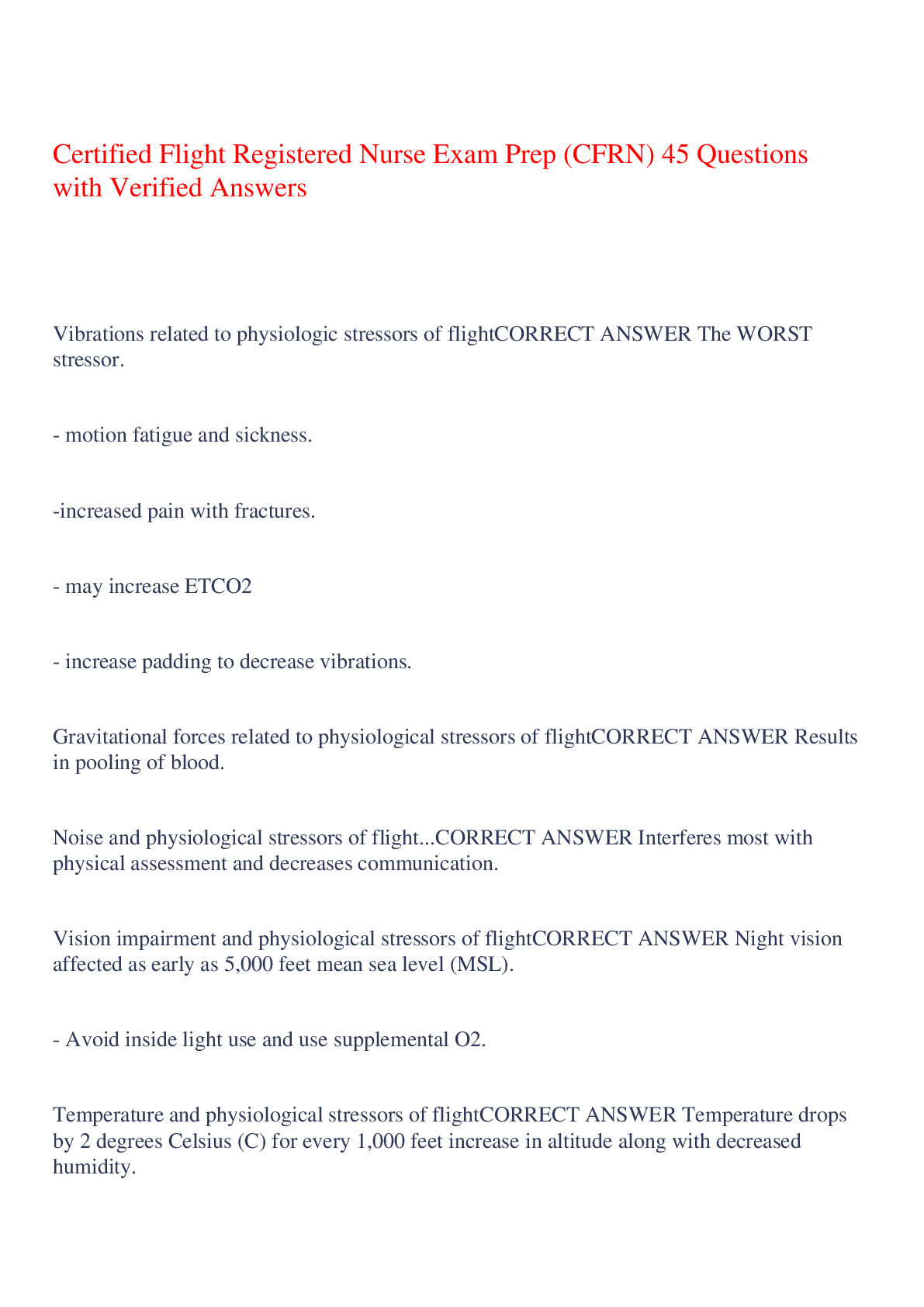
Buy this document to get the full access instantly
Instant Download Access after purchase
Add to cartInstant download
We Accept:

Reviews( 0 )
$8.50
Document information
Connected school, study & course
About the document
Uploaded On
Nov 07, 2023
Number of pages
9
Written in
Additional information
This document has been written for:
Uploaded
Nov 07, 2023
Downloads
0
Views
123













